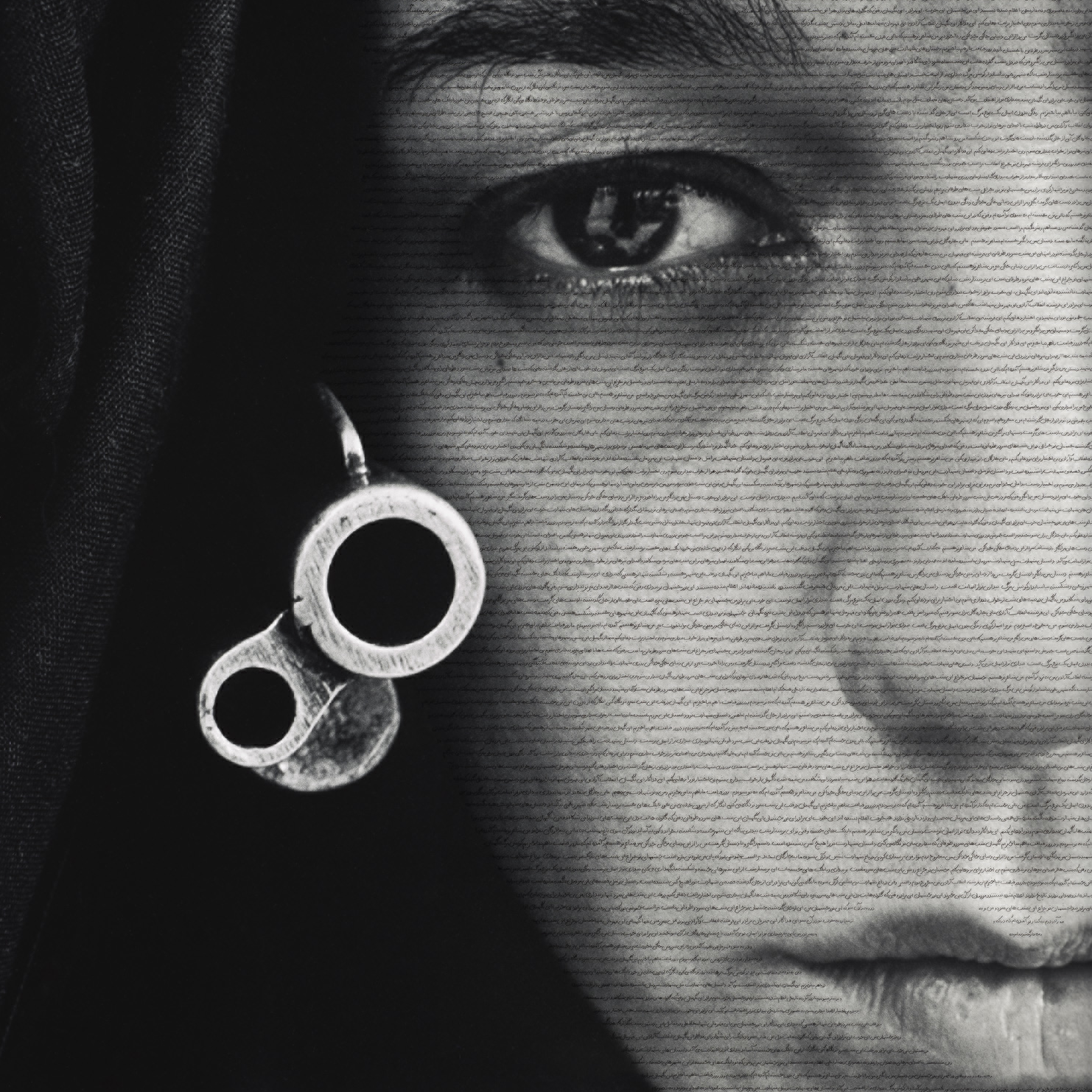Islamic Art Now at the Los Angeles County Museum of Art
Currently on view at the Los Angeles County Museum of Art (LACMA) is Islamic Art Now, the first major exhibition showcasing the museum’s impressive collection of contemporary Middle Eastern and North African art, and the largest of its kind in the United States. Featuring 25 works in a range of differing media, including photography, sculpture, video and installation art by 20 artists from Iran and the Arab world, such as Wafaa Bilal, Lalla Essaydi, Hassan Hajjaj, Mona Hatoum and Shirin Neshat, Islamic Art Now can be seen to constitute, in the words of CEO Michael Govan and Director Wallis Annenberg, the ‘contemporary counterpart to LACMA’s world-renowned historical Islamic art collection’ as well as demonstrate the profound connection between the past and the present.
LACMA houses one of the most significant collections of ‘Islamic’ art in the world, consisting of more than 1,700 works, including (but not limited to) glazed ceramics, enamelled glass, inlaid metalwork, and illustrated and illuminated manuscripts from southern Spain to Central Asia. The museum began to concentrate seriously on the arts of the Islamic (for lack of a better term) world in 1973 with the acquisition of the Nasli M. Heeramaneck Collection, during a time of rapid change and growth in the study of Islamic art. By 1972, 13 professors and seven curators of Islamic art had been appointed at American institutions; less than two decades prior to this, only one full-time teaching position existed, with just four curators in employment across the entire country. Cultural and charitable establishments responded to the sudden escalation of Western interest in the Middle East, and in 1975, the Metropolitan Museum of Art in New York opened its original suite of galleries for the display of North America’s largest and most important collection of Islamic art. The following year, London hosted the inaugural World of Islam Festival, a programme of exhibitions and events designed to introduce Islamic culture in its aesthetic, scientific, technological, musical, and intellectual entirety to the West.
It was not until 2006, however, that Linda Komaroff, LACMA’s Curator of Islamic Art, began to acquire contemporary Middle Eastern art, having been inspired by the British Museum’s Word into Art: Artists of the Modern Middle East, an exhibition curated by Dr. Venetia Porter focusing on the myriad ways in which artists of the 21st century engage and experiment with Arabic script. Thanks to Komaroff and the museum’s Art of the Middle East: Contemporary Council, a group of donors purchased Iranian artist Abbas Kowsari’s Police Women Academy (2006), along with around half of the works on display in the exhibition. Today, LACMA’s 200-strong collection is what many consider world class; even the Met’s Islamic Art Department can be said to be lacking in comparison, its holdings less diverse, with fewer contemporary works and the diminished presence of certain media, such as photography.
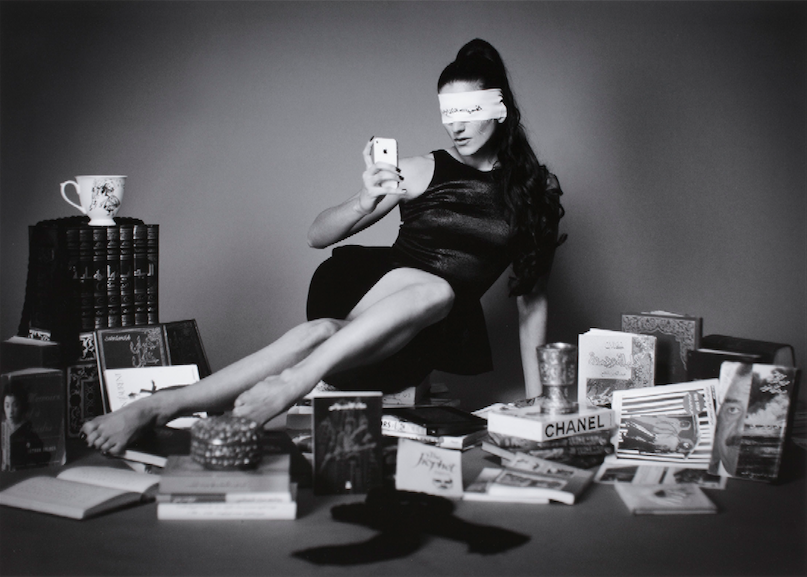
Abdullah Al Saab - Technology Killed Reality (courtesy the artist, Tamara Keleshian, and 2014 Museum Associates/LACMA; photograph by Djinane AlSuwayeh ©)
The majority of the works on display as part of the Islamic Art Now exhibition have never been shown previously at the museum. Komaroff says that until recently, a popular misconception pervaded: it was thought that Islamic art ‘ended around 1900’; yet, as this exhibition demonstrates, such claims are ill-informed. ‘The artists in this exhibition,’ Komaroff elaborates, ‘from or with roots in the Middle East, are not reinventing [historical] Islamic art, but rather repurposing it as a form of personal expression.’ As in Porter’s show at the British Museum, Komaroff has chosen to exhibit work that makes use of the Arabic – and Perso-Arabic – alphabet. Moroccan-born Lalla Essaydi’s Reclining Odalisque (2008), for example, along with two inkjet prints by Kuwaiti interior and fashion designer-turned-photographer Abdullah Al Saab’s Ayb and Technology Killed Reality (2013), as well as Mona Hatoum’s video installation, Measures of Distance (1988) are prime examples of this. Also on display are two chromogenic prints by Moroccan-British artist Hassan Hajjaj, Gang of Kesh, Part 2 (2000), and Caravane (2011). The former, surrounded in its wooden frame by car paint cans, depicts Hajjaj’s ‘Kesh Angels’, a provocatively dressed group of Moroccan girls in patterned veils and djellabas posing on motorbikes in the streets of Marrakech’s Medina. Daring and defiant, at once traditionally and yet contemporarily clad, Hajjaj’s girls subvert preconceived notions of the sociocultural role played by women in Moroccan society. Caravane, on the other hand, is a humorous portrait of the anonymous lady in red. Playful, and similarly framed by salvaged cans, Caravane exploits, thereby commenting on, the ubiquity of big brands. In addition to these works, LACMA will also host the world premiere of the artist’s first feature-length film, Karima: A Day in the Life of a Henna Girl on May 13.
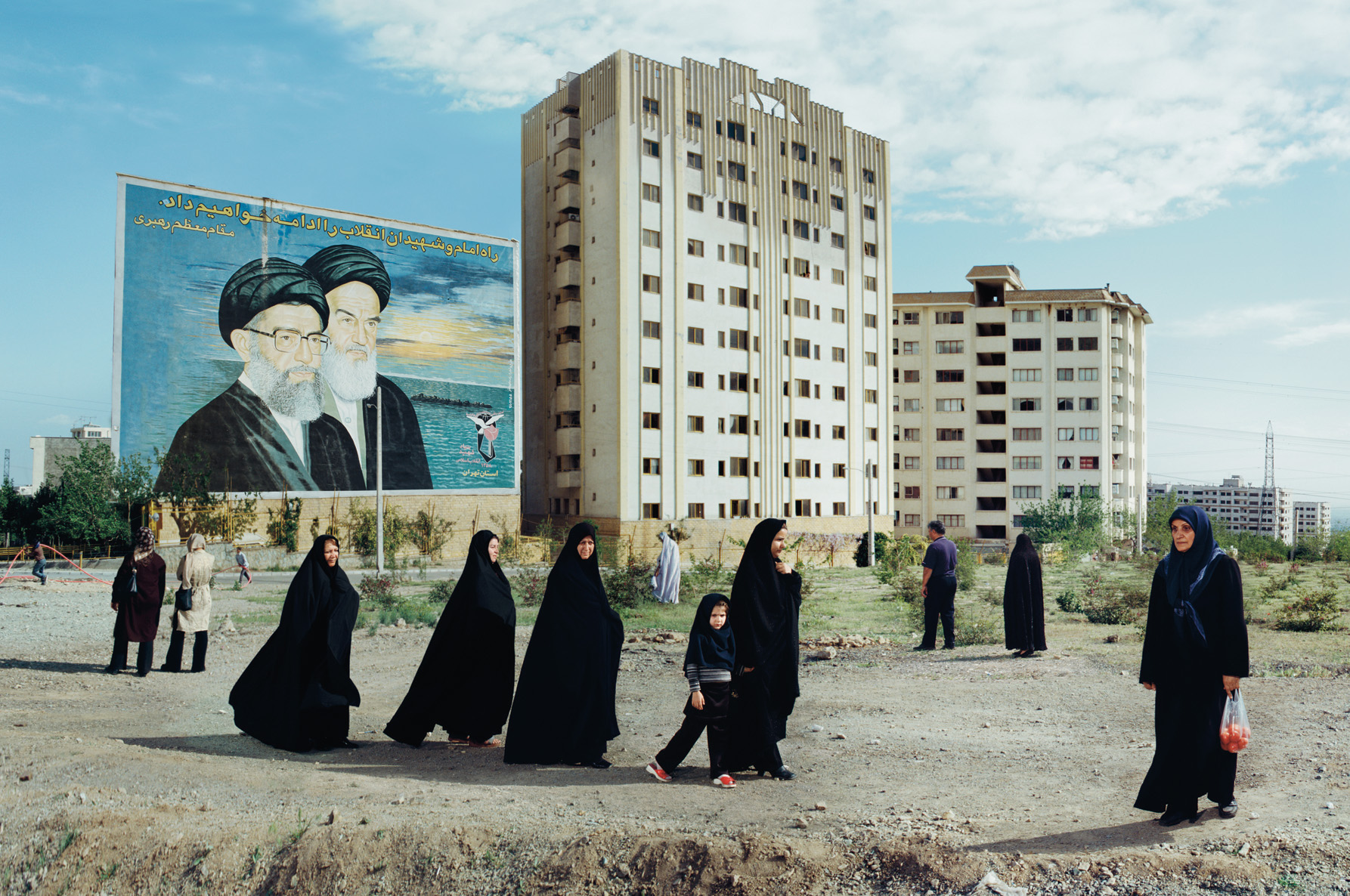
Mitra Tabrizian - Tehran, 2006 (detail; courtesy the artist, the Buddy Taub Foundation, Jill & Dennis A. Roach, Directors, through the 2014 Collectors Committee at LACMA)
Iranian-British artist Mitra Tabrizian’s photograph, simply titled Tehran, 2006, is quietly, and yet, peculiarly dramatically effective, featuring an inchoate and isolated group of individuals traversing what appears to be an area of barren wasteland on the outskirts of the city. High-rise buildings dominate the not-too-distant background, adjacent to which is a billboard featuring the faces of the late Ayatollah Khomeini and the current Supreme Leader, Ayatollah Khamenei. Tehran, 2006 is Lowry-esque in its depiction of the oddities of modern urban life. ‘They are not free’, Lowry said of the people in his paintings, of the working classes of northwest England. ‘Human beings are automatons. No one is [free].’ There is a sense in which the same is true of Tabrizian’s subjects, seeming as they do to exist in a state of suspended animation, in the eternal interim between life and death. The photograph thus possesses the quality of a glimpse, the momentary arrest of life’s curious ebb and flow.
Islamic art is difficult to define. It means different things to different people … Its use here has nothing to do with religion, or with religious art, per se; it is merely a cultural designation, a means of fixing this kind of art in a time and place
Chair (2013), a conceptual photographic work by notorious performance artist and assistant professor at New York University’s Tisch School of the Arts, Wafaa Bilal, is another highlight of the exhibition. From the Ashes series, in which the artist photographs handmade miniature reconstructions of media images documenting the destruction of buildings in the Iraq war, Chair is a haunting, visual reminder of the unsettling and uncertain distinctions between life and death. A deserted, ash-strewn stage set, Bilal’s work – a sort of memento mori – seems imbued with a kind of cryptic potential. The eponymous chair, symbolically empty, and yet indubitably indicative of human presence, serves as an unconventional ‘figuration of the motionless and made-up face, beneath which we see the dead’, to quote Roland Barthes. The artist’s position as a witness is complicated. It is clear that as an exiled Iraqi living in America, he keenly feels the impotency of his role as a spectator; he is neither able to intervene, nor bridge the dreadful abyss between experience and empathy. Bilal’s Chair is a testament, too, to the conversion of pain into art, occupying a position somewhere between private testimony and public record.
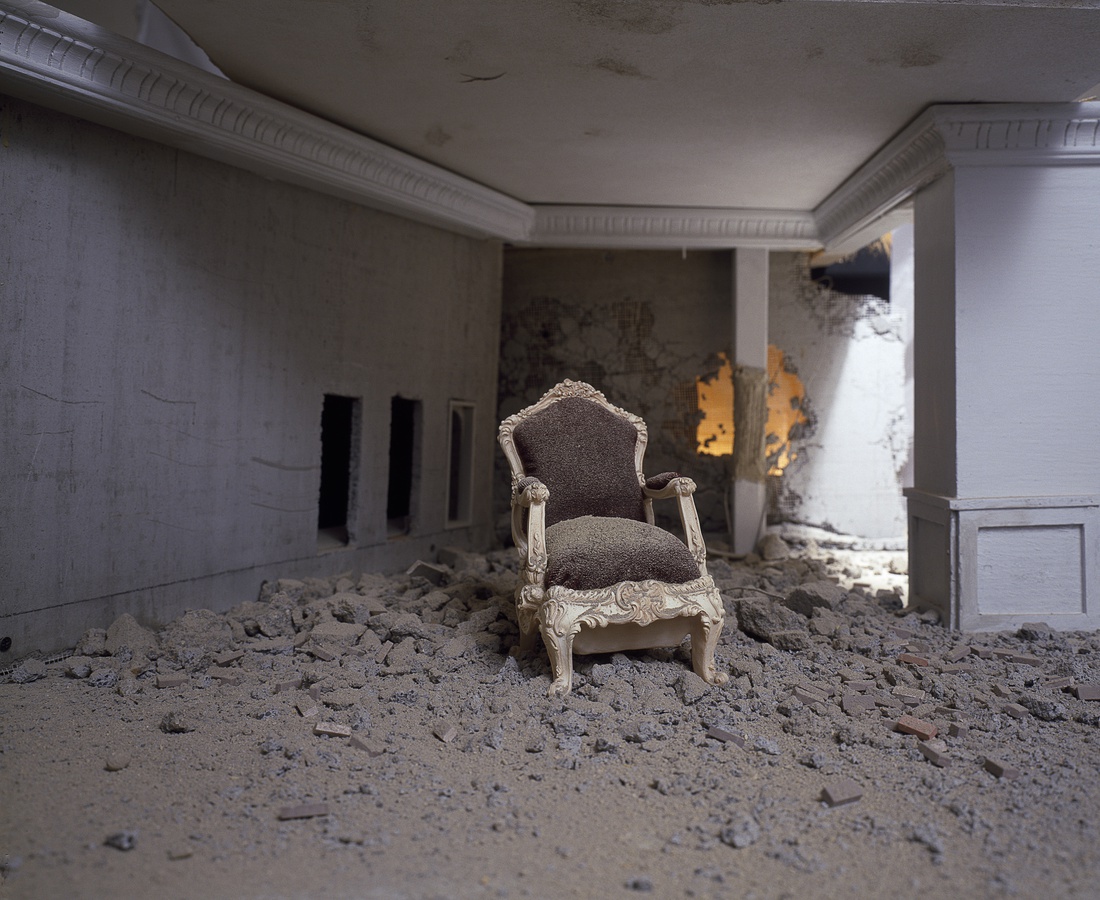
Wafaa Bilal - Chair (courtesy the artist and 2014 Museum Associates/LACMA)
The dialogue surrounding the validity of the term ‘Islamic’ as a meaningful art-historical classification continues to attract attention. Indeed, what is Islamic art, and is such a term appropriate? Komaroff asserts that ‘Islamic art is difficult to define. It means different things to different people’. She goes on to say that ‘its use here has nothing to do with religion, or with religious art, per se; it is merely a cultural designation, a means of fixing this kind of art in a time and place.’ Komaroff further opines that ‘There is no better time than now to take beautiful things and allow the term Islamic to be applied to them.’ Yet, the term might be seen as problematic, as it erroneously implies that Islam was, and is, a religious monolith. Other common criticisms include the term’s Western provenance, its anachronistic quality, and its ability to impart a sense of otherness to everything to which it is applied.
Nevertheless, the term has long served as a convenient label in art historical contexts. The Met’s decision to rename its galleries of Islamic art to ‘The Galleries for the Art of the Arab Lands, Turkey, Iran, Central Asia, and Later South Asia’, is a recent case in point. According to the museum’s Director, Thomas P. Campbell, the galleries’ reorganisation affirms that ‘The monumentality of Islam did not create a single, monolithic artistic expression, but instead connected a vast geographic expanse through centuries of change and cultural influence’. The role of Islam in shaping the character of the visual and material culture of these countries, as well as the development of a transnational, pan-historical language of style – however varied – is elsewhere duly acknowledged.
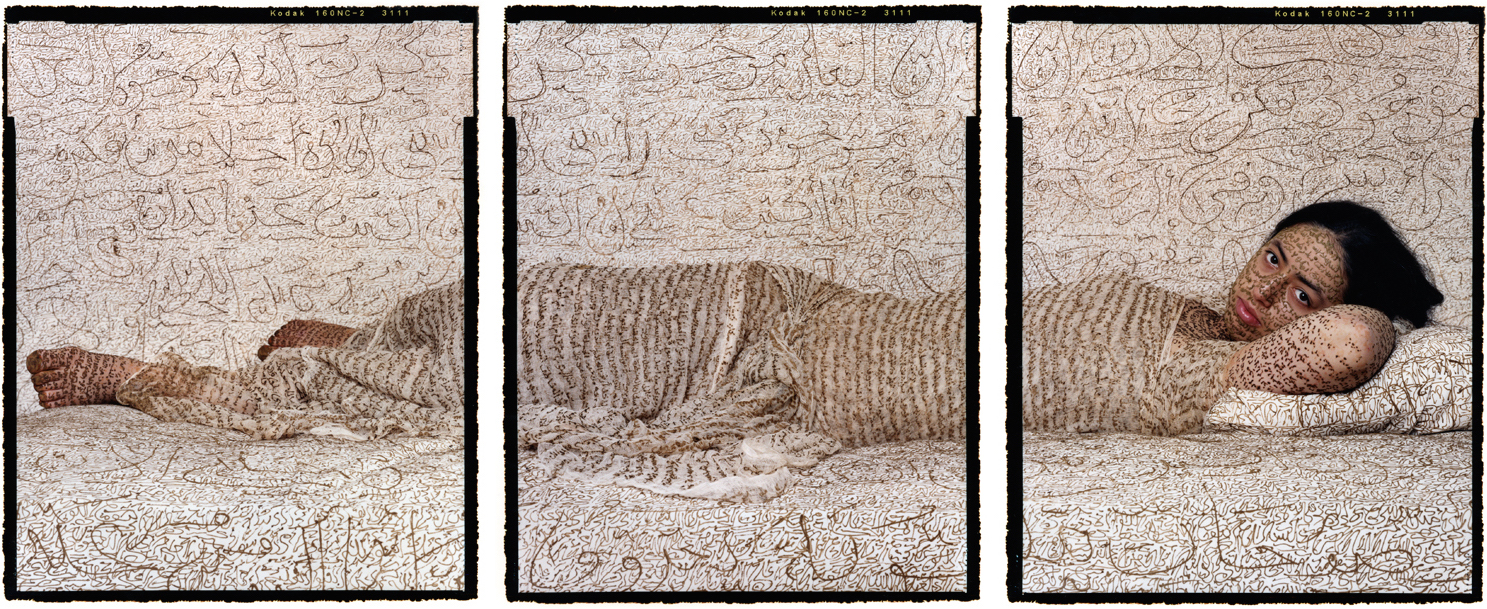
Lalla Essaydi - Reclining Odalisque (courtesy the artist and 2014 Museum Associates/LACMA)
At this stage, despite much deliberation and understandably widespread disapprobation, it seems unlikely that the term will fade into obsolescence. Islamic Art Now – whatever this multifaceted and much-disputed term might mean – can be seen as being characterised by its enduring flexibility, as well as its receptiveness to self-scrutiny and contemporary concerns.
Islamic Art Now (Part One) is currently on display at LACMA. The second part is scheduled to follow later this year.
Cover image: Shirin Neshat - Speechless (courtesy the artist, Gladstone Gallery, and 2014 Museum Associates/LACMA).
